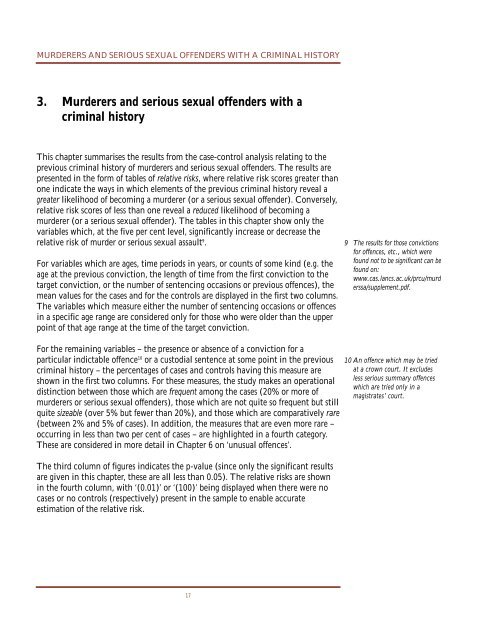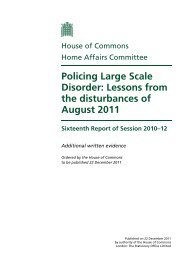Murder and Serious Sexual Assault - Lancaster EPrints - Lancaster ...
Murder and Serious Sexual Assault - Lancaster EPrints - Lancaster ...
Murder and Serious Sexual Assault - Lancaster EPrints - Lancaster ...
Create successful ePaper yourself
Turn your PDF publications into a flip-book with our unique Google optimized e-Paper software.
MURDERERS AND SERIOUS SEXUAL OFFENDERS WITH A CRIMINAL HISTORY<br />
3. <strong>Murder</strong>ers <strong>and</strong> serious sexual offenders with a<br />
criminal history<br />
This chapter summarises the results from the case-control analysis relating to the<br />
previous criminal history of murderers <strong>and</strong> serious sexual offenders. The results are<br />
presented in the form of tables of relative risks, where relative risk scores greater than<br />
one indicate the ways in which elements of the previous criminal history reveal a<br />
greater likelihood of becoming a murderer (or a serious sexual offender). Conversely,<br />
relative risk scores of less than one reveal a reduced likelihood of becoming a<br />
murderer (or a serious sexual offender). The tables in this chapter show only the<br />
variables which, at the five per cent level, significantly increase or decrease the<br />
relative risk of murder or serious sexual assault 9 .<br />
For variables which are ages, time periods in years, or counts of some kind (e.g. the<br />
age at the previous conviction, the length of time from the first conviction to the<br />
target conviction, or the number of sentencing occasions or previous offences), the<br />
mean values for the cases <strong>and</strong> for the controls are displayed in the first two columns.<br />
The variables which measure either the number of sentencing occasions or offences<br />
in a specific age range are considered only for those who were older than the upper<br />
point of that age range at the time of the target conviction.<br />
For the remaining variables – the presence or absence of a conviction for a<br />
particular indictable offence 10 or a custodial sentence at some point in the previous<br />
criminal history – the percentages of cases <strong>and</strong> controls having this measure are<br />
shown in the first two columns. For these measures, the study makes an operational<br />
distinction between those which are frequent among the cases (20% or more of<br />
murderers or serious sexual offenders), those which are not quite so frequent but still<br />
quite sizeable (over 5% but fewer than 20%), <strong>and</strong> those which are comparatively rare<br />
(between 2% <strong>and</strong> 5% of cases). In addition, the measures that are even more rare –<br />
occurring in less than two per cent of cases – are highlighted in a fourth category.<br />
These are considered in more detail in Chapter 6 on ‘unusual offences’.<br />
The third column of figures indicates the p-value (since only the significant results<br />
are given in this chapter, these are all less than 0.05). The relative risks are shown<br />
in the fourth column, with ‘(0.01)’ or ‘(100)’ being displayed when there were no<br />
cases or no controls (respectively) present in the sample to enable accurate<br />
estimation of the relative risk.<br />
17<br />
9 The results for those convictions<br />
for offences, etc., which were<br />
found not to be significant can be<br />
found on:<br />
www.cas.lancs.ac.uk/prcu/murd<br />
erssa/supplement.pdf.<br />
10 An offence which may be tried<br />
at a crown court. It excludes<br />
less serious summary offences<br />
which are tried only in a<br />
magistrates’ court.
















